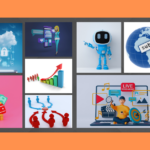“If it ain’t broke, don’t fix it.”
While marketing trends come and go, as most trends do, influencer marketing is not going anywhere. If done well, it’s highly profitable.
Hubspot found that nearly 90% of marketers that use it will maintain or increase their budget. And another 17% who’ve never tried it will give it a shot at some point this year.
Initially, influencer marketing was used exclusively for the B2C crowd. Then, some B2B businesses started dabbling. This makes the B2C SaaS market a great spot to use influencers.
Is there really any utility in influencer marketing for SaaS products? What are some strategies on how to leverage influencers for optimal product promotion?
We’ll highlight how influencers can help you connect with the right people online and drive customer acquisition. There are plenty of dos and don’ts. Let’s get started.
Table of Contents
B2C SaaS Marketing VS. B2B: What’s the Difference?

Before we dive into B2C SaaS marketing and influencers, it’s worth understanding the key differences between business-to-business (B2B) and business-to-consumer (B2C) tactics.
They cater to entirely different sets of customers
And because of this, the marketing strategies are different. A lot different.
B2B marketing typically involves targeting a smaller group of individuals with more personalized and informative content. B2C marketing aims to reach larger audiences with compelling and relatable messages.
Influencer marketing, in particular, has emerged as a potent tool for B2C marketers seeking to create a buzz around their products.
How Are B2C Marketing Strategies Different?
The primary objective of any marketing campaign is to engage and attract potential customers.
For B2C marketing, influencers can play a crucial role in driving consumer behavior.
Unlike B2B, where sales cycles are longer and require more substantial investments, the B2C market thrives on mass appeal and quick decision-making. It’s often about appealing to impulse buyers.
Consumers tend to trust recommendations from people they follow on social media or trust in real life. That fact makes influencer marketing a powerful tool to sway their purchasing decisions.
What Are SaaS Influencers?
SaaS influencers are individuals or entities with a significant following and expertise in the SaaS domain.
They can be anyone from industry experts to popular bloggers. Social media personalities are always sought after. They use their platform to share insights and promote products related to the SaaS industry.
Influencers are particularly impactful as they have an established relationship with their followers, making their recommendations more credible and influential.
The Different Levels of Influencers
Before you start making a list of which Kardashian you want to help promote your SaaS products, there are a few things we should go over.
First, celebrity-level influencers are expensive. While they have many followers, sometimes in the tens of millions, most won’t buy anything the influencers promote.
Nano and micro-influencers will provide the highest ROI. Because their follower numbers are smaller, people view them as more honest. A lot of their following is comprised of folks who are in their personal and professional network.
Do you personally know a Kardashian? No? Neither do we.
But we have a neighbor named Bob. Most people do. If he tells us that he test-drove ten minivans over the weekend and the best one is the best for x,y, and z reasons, we’re inclined to give him the benefit of the doubt, right?
Bob is an influencer. People listen to Bob. They believe Bob. Bob’s a good guy.
When influencer marketing for SaaS products, you want an army of Bobs for your business.
Influencer Categories

Before we go any further, here’s the influencer hierarchy:
- Mega-Influencers: These are usually celebrity-level influencers with over one million followers. The Kardashians. The Tay-Tays. The Dwayne Johnsons. You get the idea. You…smell what The Rock is cookin’.
- Macro-Influencers: These influencers have a massive following, typically more than 100,000 followers but fewer than one million. Some of these people got famous just for being an influencer. They push products hard, but they push a lot of products and probably won’t spend much time using yours.
- Micro-Influencers: These influencers have a smaller but highly engaged fan base of around 10,000 to 100,000 followers. This is where things get interesting. They’re hungry for more followers. But that can also make them a bit greedy. Still, a goldmine if you play it right.
- Nano-Influencers: These influencers have a few thousand followers but have highly specialized knowledge or expertise in a particular niche. They are the creme de la creme of ROI. Loyal fanbase. Honest. Highest ROI in influencer marketing.
What’s in It for You? The Benefits of Influencer Marketing for SaaS Products
You want customers. You need them to stay alive.
In the SaaS world, nothing is more potent than word-of-mouth marketing. And no one does that better than an influencer. Here are some benefits if you find quality influencers and run a great campaign.
- Building brand credibility: Influencer recommendations are highly trustworthy and credible to their followers.
- Creating brand awareness: By promoting your SaaS product, influencers can increase brand visibility and reach potential customers who may not have heard of it.
- Targeting specific demographics: Influencers often have a niche following. This allows you to target specific demographics or interest groups.
- Increasing website traffic: Influencers can direct their followers to your website through links or swipe-up features on social media platforms. More traffic is a strong signal your campaign is working. Conversion should follow. If they don’t, the campaign doesn’t need to be scrapped – just tweaked.
How to Leverage Influencers for B2C SaaS Marketing

If you want to know how to leverage influencers for B2C SaaS marketing campaigns, you must be strategic.
Influencer marketing can be an ideal strategy for reaching your target audience. It can build brand awareness and drive customer acquisition.
Here are some strategies to help you get started:
- Identify the right influencers: Look for influencers who align with your brand’s values and have an engaged following with people you’d love to have as customers.
- Collaborate on content creation: Work with influencers to create engaging and informative content. Don’t be generic. It’s death. If the influencer doesn’t want to put in work, then find someone else. Don’t hand them a free lunch.
- Curated giveaways and promotions: Partner with influencers to host giveaways or offer exclusive discounts promoting your product. Requirements for entering can be following your socials, engaging with them, email grabs, etc…
- Sponsored posts: Pay influencers to promote your SaaS product through sponsored posts on their social media platforms or blogs. This route is a bit of a copout and probably won’t have as high of a return as other ideas on this list.
- Product reviews and demos: Have influencers review your product or conduct live demos, showcasing its features and benefits to their followers. This is one of the most popular methods for a reason. It works.
Influencer Marketing for SaaS Companies – Tips and Tricks
The key to influencer marketing for SaaS companies is the same as with most marketing methods. You have to understand your target audience and their preferences. Don’t rely on the influencer to do everything.
No one knows your product as well as you.
Here are some techniques that can help you achieve maximum impact:
- Use social media platforms: Social media is the best tool to reach a B2C audience. It’s also the best place to connect with influencers in your industry.
- Create visually appealing content: B2C audiences respond well to visually stimulating content. Your product photos and videos must be eye-catching.
- Leverage user-generated content: Encourage customers to share their experiences with your SaaS product on social media. This goes hand in hand with the idea above of having contests and giveaways.
- Engage with micro-influencers: Stay in touch with influencers. Share their content, even if it does not concern your product. Interact with their followers. Show them that the working relationship is mutually beneficial.
ROI: Measuring the Success of Influencer Marketing

“Measure twice, cut once.”
This applies to marketing. You measure and then cut. And then do it again. And again. And again.
There is no such thing as perfect marketing. There is too much variance in the world. Business is constantly evolving. Your business has to do the same.
Measuring ROI identifies where your campaigns are successful. And where they’re lacking.
Use these metrics to help you determine where you can adjust tactics and where you’re hitting the proverbial nail on the head.:
- Engagement rates: This measures how many users interacted with your content. We’re talking likes, comments, shares, and clicks. It’s top-of-the-funnel stuff. People don’t know about a party until someone tells them about it.
- Follower growth: Keep an eye on your follower count during and after the influencer campaign. You should see an impact on your brand’s following.
- Website traffic: Track website visits from referral sources. This is where you learn which influencers are pulling their weight and which are collecting a free check.
- Conversions: Sales. The success of influencer marketing should be measured by its impact on your sales and customer acquisition. If you run influencer campaigns and don’t get any sales, it’s time to get back to the drawing board.
Metrics for Evaluating Influencer Marketing Campaigns
Sometimes, you want to put a campaign under a microscope. Maybe view it with a different lens. While the macro-impact affects your bottom line, you should also evaluate your campaigns on a per-channel level.
Is Twitter right for your brand? Is Facebook better? The only way to find out is to measure individual metrics of each platform against another. Use these metrics to figure that out.
If your campaigns aren’t successful, it could have nothing to do with the influencer. It could have everything to do with Instagram or TikTok not being the right platform for your business. Keep a close watch on the following:
- Reach: Refers to the number of people who saw or were exposed to your content through an influencer’s post.
- Impressions: How many times your content was seen. It reflects the potential reach of your campaign.
- Click-through rate (CTR): Measures how many users clicked on a link or CTA in your content. It indicates interest and intent to learn more about your SaaS product.
- Cost-per-engagement (CPE): The average cost of each engagement generated through an influencer’s post. If this number is really high, the juice is not worth the squeeze.
The Dos and Don’ts of Influencer Marketing for SaaS Products

To sum it up, here are some dos and don’ts to keep in mind when leveraging influencer marketing for your B2C SaaS product:
Dos:
- Do your research and carefully select the right influencers for your brand.
- Collaborate with influencers on creating authentic and engaging content that resonates with their audience.
- Monitor and track the performance of your influencer marketing campaigns.
- Consider long-term partnerships with influencers to build a stronger relationship and generate a more significant impact over time.
Don’ts:
- Don’t choose influencers solely based on their follower count. Look for genuine engagement and relevance to your brand instead.
- Avoid being too promotional in your collaborations with influencers. Focus on creating valuable content that organically showcases your product’s benefits.
- Don’t ignore negative feedback or comments from users. Address them promptly and professionally to maintain your brand’s credibility.
Influencer Marketing for SaaS Brands – One of the Best Tools for Marketing Campaigns
Influencer Marketing for SaaS brands presents a potent tool for B2C SaaS marketing efforts. It will enhance brand visibility. You’ll build credibility and drive customer acquisition.
The success of using SaaS influencers lies in carefully selecting ambassadors. Don’t base your campaign solely on follower count. Look for genuine engagement and brand relevance.
Knowing how to leverage influencers involves a lot of work on your end. At least end the beginning. Create appealing content and encourage user-generated content to boost your efforts.
One of the biggest challenges concerning how to leverage influences is measuring ROI.
Influencer marketing can unlock expansive growth opportunities for your SaaS product. But you have to use this tactic with diligence and calculated purpose.





Thank you for your sharing. I am worried that I lack creative ideas. It is your article that makes me full of hope. Thank you. But, I have a question, can you help me?
Glad to hear you found this article helpful. You are welcome to email any questions you may have to maddy@techtonic-marketing.com.